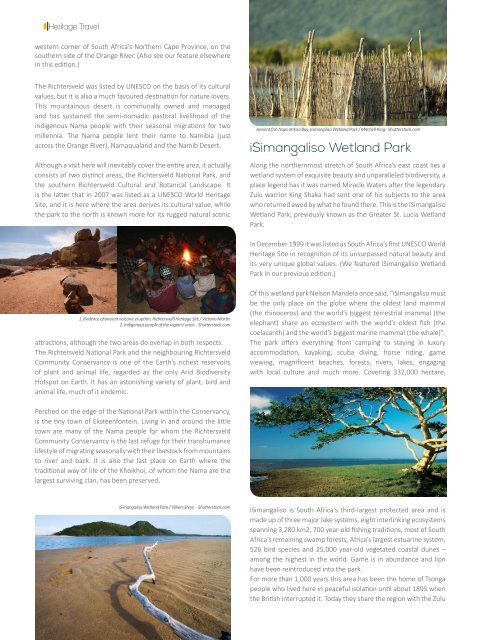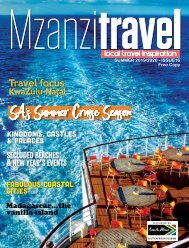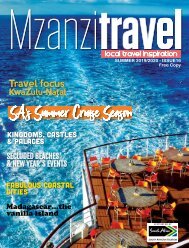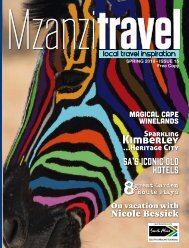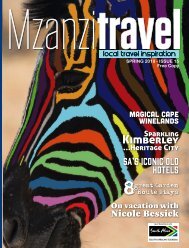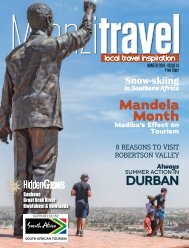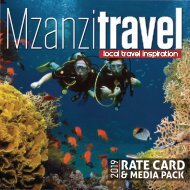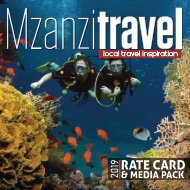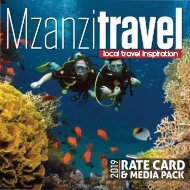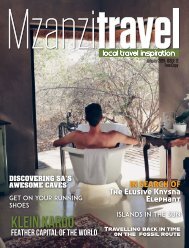Create successful ePaper yourself
Turn your PDF publications into a flip-book with our unique Google optimized e-Paper software.
Heritage Travel<br />
western corner of South Africa’s Northern Cape Province, on the<br />
southern side of the Orange River. (Also see our feature elsewhere<br />
in this edition.)<br />
The Richtersveld was listed by UNESCO on the basis of its cultural<br />
values, but it is also a much favoured destination for nature lovers.<br />
This mountainous desert is communally owned and managed<br />
and has sustained the semi-nomadic pastoral livelihood of the<br />
indigenous Nama people with their seasonal migrations for two<br />
millennia. The Nama people lent their name to Namibia (just<br />
across the Orange River), Namaqualand and the Namib Desert.<br />
Although a visit here will inevitably cover the entire area, it actually<br />
consists of two distinct areas, the Richtersveld National Park, and<br />
the southern Richtersveld Cultural and Botanical Landscape. It<br />
is the latter that in 2007 was listed as a UNESCO World Heritage<br />
Site, and it is here where the area derives its cultural value, while<br />
the park to the north is known more for its rugged natural scenic<br />
Ancient fish traps at Kosi Bay, Isimangiliso Wetland Park / Mitchell Krog - Shutterstock.com<br />
iSimangaliso Wetland Park<br />
Along the northernmost stretch of South Africa’s east coast lies a<br />
wetland system of exquisite beauty and unparalleled biodiversity, a<br />
place legend has it was named Miracle Waters after the legendary<br />
Zulu warrior King Shaka had sent one of his subjects to the area<br />
who returned awed by what he found there. This is the iSimangaliso<br />
Wetland Park, previously known as the Greater St. Lucia Wetland<br />
Park.<br />
In December 1999 it was listed as South Africa’s first UNESCO World<br />
Heritage Site in recognition of its unsurpassed natural beauty and<br />
its very unique global values. (We featured iSimangaliso Wetland<br />
Park in our previous edition.)<br />
1. Evidence of ancient volcanic eruption, Richtersveld Heritage Site / Victoria Martin<br />
2. Indigenous people of the region / urosr - Shutterstock.com<br />
attractions, although the two areas do overlap in both respects.<br />
The Richtersveld National Park and the neighbouring Richtersveld<br />
Community Conservancy is one of the Earth’s richest reservoirs<br />
of plant and animal life, regarded as the only Arid Biodiversity<br />
Hotspot on Earth. It has an astonishing variety of plant, bird and<br />
animal life, much of it endemic.<br />
Of this wetland park Nelson Mandela once said, “iSimangaliso must<br />
be the only place on the globe where the oldest land mammal<br />
(the rhinoceros) and the world’s biggest terrestrial mammal (the<br />
elephant) share an ecosystem with the world’s oldest fish (the<br />
coelacanth) and the world’s biggest marine mammal (the whale)”.<br />
The park offers everything from camping to staying in luxury<br />
accommodation, kayaking, scuba diving, horse riding, game<br />
viewing, magnificent beaches, forests, rivers, lakes, engaging<br />
with local culture and much more. Covering 332,000 hectare,<br />
Perched on the edge of the National Park within the Conservancy,<br />
is the tiny town of Eksteenfontein. Living in and around the little<br />
town are many of the Nama people for whom the Richtersveld<br />
Community Conservancy is the last refuge for their transhumance<br />
lifestyle of migrating seasonally with their livestock from mountains<br />
to river and back. It is also the last place on Earth where the<br />
traditional way of life of the Khoikhoi, of whom the Nama are the<br />
largest surviving clan, has been preserved.<br />
iSimangaliso Wetland Park / Villiers Steyn - Shutterstock.com<br />
iSimangaliso is South Africa’s third-largest protected area and is<br />
made up of three major lake systems, eight interlinking ecosystems<br />
spanning 3,280 km2, 700 year-old fishing traditions, most of South<br />
Africa’s remaining swamp forests, Africa’s largest estuarine system,<br />
526 bird species and 25,000 year-old vegetated coastal dunes –<br />
among the highest in the world. Game is in abundance and lion<br />
have been reintroduced into the park.<br />
For more than 1,000 years this area has been the home of Tsonga<br />
people who lived here in peaceful isolation until about 1895 when<br />
the British interrupted it. Today they share the region with the Zulu


